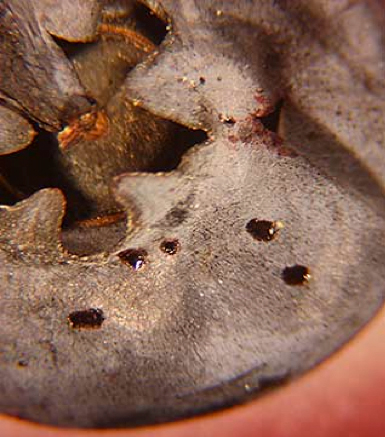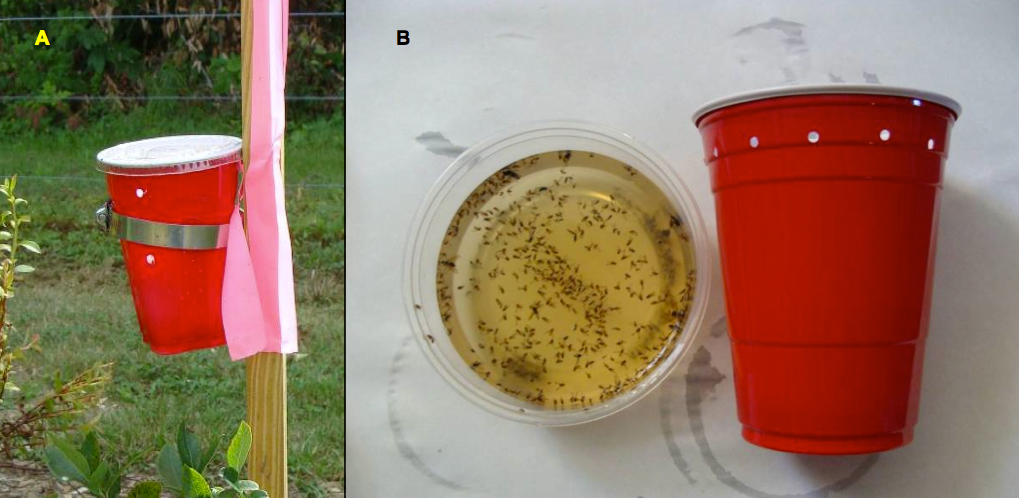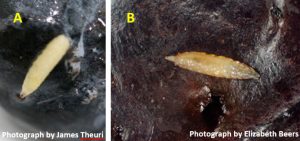210-Spotted Wing Drosophila: Pest Biology and IPM Recommendations for Wild Blueberries
Fact Sheet No. 210
Prepared by Frank Drummond, Professor of Insect Ecology; Elissa Ballman, Entomologist; Judith Collins, Entomologist; and David E. Yarborough, Extension Blueberry Specialist, The University of Maine, Orono, ME 04469. January 2018.
The spotted wing drosophila (SWD) has the scientific name: Drosophila suzukii (Matsumura). This serious pest is native to parts of Southeastern China, North and South Korea, and Southern Japan. It was first detected in Hawaii in 1980 but was recently found in California in 2008. After its accidental introduction into California, SWD spread rapidly to Oregon, Washington, British Columbia, and Florida in 2009; then to Utah, Wisconsin, Michigan, Louisiana, and South and North Carolina in 2010. In 2011 it was detected in New York, all of New England, including Maine in October 2011; and by 2012 this pest was found throughout the Canadian Maritimes and Quebec.
Unlike our native blueberry maggot fruit fly (Rhagoletis mendax Curran), SWD is polyphagous, meaning it feeds on many different host plants, including most thin-skinned fruit crops and many of our native fruit trees and shrubs. The major hosts of concern to Maine agriculture are wild blueberries, highbush blueberries, day-neutral strawberries, and fall raspberries. Though crop losses have not been quantified in Maine as of yet, research in California determined losses to be as high as 40 percent for blueberries and 20 and 50 percent losses in strawberries and raspberries, respectively.
Identification, Life Cycle, and Damage
The spotted wing drosophila is in the family Drosophilidae, known commonly as vinegar, fruit, or pomace flies. This pest shares many physical characteristics that are similar to the common vinegar fly, Drosophila melanogaster that frequents over-ripe and damaged fruits in the kitchen.

Adults have rounded abdomens that are pale yellow to light brown and have dark brown, unbroken horizontal stripes on the dorsal side. They have large, bright red eyes and sponging mouthparts with which they sponge up their food. The male flies can be easily distinguished from other vinegar flies by the single dark spot at the tip of each wing (Figure 1A). In the field, these spots can be seen with the naked eye or a hand lens. The SWD can also be distinguished by two rows of spines on their forelegs. These rows of spines appear as two black horizontal stripes on the forelegs when using a hand lens (Figure 1 B). Female SWD is slightly larger than the males and lacks the wing-spots (Figure 1C).


They can, however, be identified by their large, dark, and heavily serrated ovipositor with which they use to pierce the skin of their host fruit and lay their eggs (Figures 2 and 3). The females should be identified using a microscope or at least a strong hand lens.
SWD has been shown to have as many as 15 generations per year when observed in captivity. These flies can complete their life cycle in 21 days and the adult flies can live for up to 66 days during the summer. Females lay one to three eggs per egg-laying hole, with an average of 380 eggs throughout her lifetime and multiple female SWD can lay eggs on a single fruit, resulting in large numbers of larvae (5-25) in one blueberry.
Eggs are milky white and oblong in shape and very small, approximately 0.5 mm by 0.2 mm (0.02 to 0.08 inches). They have two long, thread-like appendages used for breathing that protrude from the skin of the blueberry. These can be seen with a microscope or a strong hand lens. Eggs hatch inside the berry, one to three days after being laid.
Larvae are very small and are extremely difficult to identify even by trained professionals. They are thin, white, and soft-bodied with pointed anterior and posterior ends (Figure 4B). Their mouthparts appear black on the anterior end. SWD have three larval stages (instars), and all take place inside the berry. The full larval period of all three larval instars takes only four to five days!

Pupae are oblong-shaped and range from light brown to dark brown as the pupa develops (Figure 4C). There are spiked protrusions from the anterior end of the pupae that are used in breathing. As the pupae get closer to the emergence of the adult fly, the red eyes and wings of the fly can be seen through the pupal skin. Pupation occurs inside or outside the fruit, in the soil and occurs in four to five days.
SWD Integrated Pest Management Program (IPM) for Wild Blueberries in Maine
Our integrated pest management program for SWD is focused on 1) monitoring, 2) cultural control, and 3) use of effective insecticides.
Adult Monitoring
SWD will lay eggs in red and blue blueberry fruit that is still maturing, therefore, monitoring should begin as green berries begin to turn pink. Traps should be hung in a shady area on the field edge in a shrub or small tree at chest height. A minimum of two traps per five acres should be deployed (Figure 5). The majority of the traps should be placed along the perimeter of the field but a few traps should be placed towards the field interior. The field interior traps should be hung from a stake three to four feet above the ground. Traps should be visited at least once per week, but preferably twice a week. During each visit, fly samples should be collected from the traps and then the traps should be emptied and replaced with fresh bait.
The trap recommended for SWD monitoring is a RED plastic cup trap made from a 16-32 oz. Solo type cup and lid with eight to ten, 1/8 to 3/16 inch diameter holes drilled along the upper rim see Figure 5. A twist tie or wire can be used to hang the trap in a shrub or a garden stake. Some trap designs include a 2-inch x 2-inch yellow sticky card inside the trap; we have found that captures do not increase with the addition of the card, but the small square trap does facilitate inspecting the trap for SWD. Traps are baited with approximately 1.5 to 2 inches (150 ml or about 5 oz.) of either apple cider vinegar or a yeast-sugar-water mixture. The yeast-sugar-water mixture is made of 1 TBSP yeast, 4 TBSP sugar, and 12 oz. of water (also see Wild Blueberry Fact Sheet on Spotted Wing Drosophila Traps).

In Maine, we have shown that the yeast sugar syrup bait to be MUCH MORE effective at capturing SWD than apple cider vinegar during August and September. In cooler conditions, results suggest that the yeast mixture may not react as intensely and the vinegar may perform better. The vinegar is also inexpensive, easy-to-use, and specimens can be identified easily. Cowles bait is also more effective than apple cider vinegar but contains more ingredients (also see Wild Blueberry Fact Sheet on Spotted Wing Drosophila Traps).
Larval Monitoring
Monitoring for larvae is done using the Salt Test. To do this, collect at least a quart of RIPE berries raked from several locations throughout the field, but especially along the field edges. Place the berries in a re-sealable one-gallon plastic bag. Mix a salt solution of 1/4 cup salt to four cups water. Lightly crush the berries in a bag and add the salt solution. Allow the fruit to sink to the bottom of the bag and wait approximately 30 min. Strain the fruit and liquid through a coarse sieve into a dark colored pan or tray. Discard the fruit in the sieve and search the strained liquid for maggots which will sink to the bottom of the pan. Larval monitoring should be conducted frequently as this pest can be explosive in their late summer buildup in a field.

Blueberry maggot flies and spotted wing drosophila can be present in the fruit during the same time period so it is important to be able to distinguish between their larvae (Figure 6). Blueberry maggot fly larvae are pointed on one end, and blunted, or rounded, on the other end. In contrast, spotted wing drosophila larvae are pointed at both ends.
Cultural Control: We have NOT YET TESTED any cultural control for SWD in Maine. Those tactics that are recommended in other states for various fruit crops and MIGHT be somewhat effective in wild blueberry are:
EARLY Harvest and Frequent Harvest Intervals: SWD in Maine appears to be a mid to late season pest. Thus early harvest (prior to August) may result in avoiding SWD infestation. In addition, frequent harvests of clones as they become ripe through the season should help keep susceptible fruit off of the plants and MAY help to reduce the SWD population buildup. During peak harvest, intervals might be every one to three days.
Exclusion Netting: Mesh netting MAY help prevent SWD infestation in wild blueberries when hole size is less than 1 mm and reduce entry into the field by 100 percent when the mesh size is less than 0.98 mm or 0.04 inches. Netting should be placed over select clones once pollination is complete. Netting can be an expensive and labor-intensive option but may prove viable for small or organic wild blueberry growers. Netting can be obtained from greenhouse supply companies that sell “thrips” netting.
Trapping Out: Wild blueberry is a dense crop and it is not known if trapping out this pest is feasible. The recommended approach (this is experimental) is to deploy SWD traps with a highly attractive sugar syrup/yeast bait (see above: Adult Monitoring) 25 feet apart in a grid throughout the section of blueberry field targeted for protection. Baits should be replaced weekly and larval monitoring should be conducted to determine if trapping out is effective.
Action Thresholds
The capture of male SWD does not necessarily mean that infestation of fruit will immediately follow. We have been developing a database of male fly captures and the associated likelihood of infestation by SWD the following week (based upon six years of data). These data have allowed us to estimate likely thresholds for varying levels of acceptable risk. Specifically, we have determined the risk of blueberry fruit infestation the week following trap captures of MALE SWD flies. The data is based upon three traps/field edge, BUT the thresholds can be based upon any number of traps in a field. It should be remembered that less than 3 traps per field may not be enough to detect SWD early on. An average capture of one male SWD results in a 99% chance of no infestation the following week. An average of 3.5 male SWD results in a 90% chance of no infestation the following week. An average of seven male SWD results in a 75% chance of no infestation the following week. Caution is still advised for following these thresholds; we STRONGLY RECOMMEND that when relying upon these thresholds, a fruit sample should be taken (see methods above) so that lack of infestation can be verified.
The way that Table 1 can be used might be based upon the risk of fruit infestation a particular grower is willing to accept. For instance, a farm that is highly averse to fruit infestation risk might select a threshold of one male per trap; although, for those growers very averse to risk, a threshold of 0.5 cumulative males SWD is recommended. A grower with moderate risk aversion might select a threshold of two, and a grower with a low aversion to risk might select a threshold of three to four male flies per trap. Trap inspection should be conducted at least weekly, but twice a week is much better since SWD can buildup in wild blueberry fields very quickly.
| Table 1. ACTION THRESHOLDS. Data from 2012-2017 that show the frequency (# fields) of cumulative SWD male captures in fields that the following week had infested fruit. | |
| CUMULATIVE MALE SWD FLIES CAPTURED (average from three traps/field) |
Probability of NOT having infested fruit the following week |
| 0.25 | 99.9% |
| 0.5 | 99.5% |
| 1.0 | 99% |
| 2.0 | 95% |
| 3.5 | 90% |
| 7.0 | 75% |
| 16.0 | 50% |
If thresholds are attained, then the grower can either: 1) commence an insecticide control strategy to protect the crop until harvest (see insecticide recommendations for SWD, Factsheets: Spotted Wing Drosophila Update; Insecticide Control for Wild Blueberries #209) or harvest the field immediately.
Insecticide Control
A decision to spray should be based on monitoring data. This information is obtained from monitoring traps or it could be based on larval counts from berries. The problem with information taken from larval counts is that by the time the larvae are found it is usually too late for spraying as a large percentage of the fruit will already be infested. Therefore, we recommend ADULT trapping. Upon trapping the FIRST MALE (wings with spots) SWD the grower should consider harvesting immediately if this is practical or protecting the crop with insecticides. Table 2 provides a list of compounds recommended for SWD control in Maine. If spraying occurs for an extended period of time, the same insecticide should not be used more than two times in a row before rotating to an insecticide with a different class. Rotating among the various classes can delay the onset of resistance to the insecticides used.
In addition, the grower should consult the buyer of blueberries to determine what insecticides will fit with their global marketing MRL restrictions. An attempt should be made to manage weeds in the field so that spraying for SWD has a minimal effect on pollinators. Regular monitoring for adults and larvae should continue during the application of insecticides.
| Table 2. Insecticides registered for use against SWD in wild blueberry in Maine (2018). | ||||
| Efficacy Ranking1 | Trade name | Rate | Class3 | PHI (days)4 |
|---|---|---|---|---|
| Very Effective | Mustang Maxx | 4 oz. | Pyrethroid | 1 |
| Very Effective | Brigade WSB, 2EC | 16 oz; 2.1-6.4 oz. | Pyrethroid | 1 |
| Very Effective | Delegate WG | 3-6 oz. | Spinosyn | 3 |
| Very Effective | Imidan 70 WP | 1.3 lb. | Organophosphate | 3 |
| Effective | Malathion 8F | 2.5 pts . | Organophosphate | 1 |
| Effective | Entrust SC2 | 4-6 oz. | Spinosyn | 3 |
| Effective | Exirel | 13.5-20.5 oz. | Ryanoid | 3 |
| Fair Effectiveness | Sevin 4 | 1.5-2 qts. | Carbamate | 7 |
| Fair Effectiveness | Assail 30 SG | 4.5-5.3 oz. | Neonicotinoid | 1 |
| Fair Effectiveness | Montana 2F, 4F | 4.8-6.4 oz.; 2.4-3.2 oz. | Neonicotinoid | 3 |
| Limited Effectiveness | AzaGuard, AzaSol | Use label rates | Limonoid/ Triterpenoid |
0 |
| 1 Efficacy based upon field tests on various fruit crops in other states. 2 an organic formulation 3 For management of spotted wing drosophila (SWD) resistance to insecticides, growers should use products from one mode of action group during the period of one SWD lifecycle then rotate to another mode of action for a similar period. 4 PHI – Pre-harvest interval – the period that must pass between the application of a selected insecticide and harvest of the crop. ALWAYS follow label instructions. |
||||
Credits: Portions of this factsheet was taken from Publication # 2, SWD University of Florida, IFAS Extension publication. February 2013. Oscar Liburd is a professor of fruit and vegetable entomology, Univ. of Florida and Lindsy Iglesias is a graduate research assistant in the Small Fruits and Vegetable IPM laboratory at the University of Florida. In addition, photos were taken from the University of Florida and Oregon State University Cooperative Extension Factsheets. Figure 5 photos are credited to Dr. David Handley, University of Maine Cooperative Extension.
Information in this publication is provided purely for educational purposes. No responsibility is assumed for any problems associated with the use of products or services mentioned. No endorsement of products or companies is intended, nor is criticism of unnamed products or companies implied.
© 2018
Call 800.287.0274 (in Maine), or 207.581.3188, for information on publications and program offerings from University of Maine Cooperative Extension, or visit extension.umaine.edu.
The University of Maine is an EEO/AA employer, and does not discriminate on the grounds of race, color, religion, sex, sexual orientation, transgender status, gender expression, national origin, citizenship status, age, disability, genetic information or veteran’s status in employment, education, and all other programs and activities. The following person has been designated to handle inquiries regarding non-discrimination policies: Director of Equal Opportunity, 101 Boudreau Hall, University of Maine, Orono, ME 04469-5754, 207.581.1226, TTY 711 (Maine Relay System).
